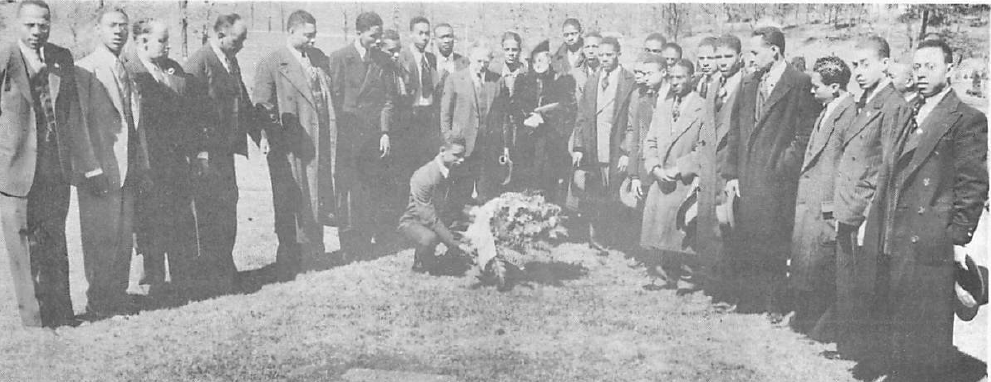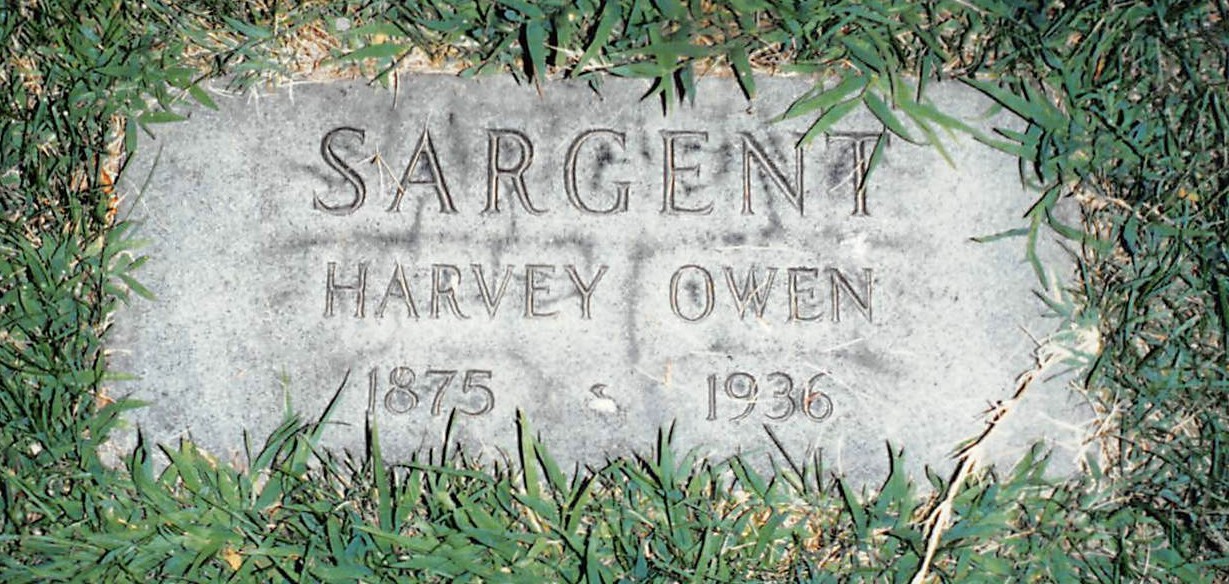In recent Footnotes, we have focused on Henry Groseclose who is considered by many as the key player in the establishment of the Future Farmers of America. It would be appropriate to give the same attention to the two primary co-founders of the New Farmers of America. Can you name them? They are George Washington Owens and Dr. H. O. Sargent. In the Footnote, we will learn more about these two individuals.
After the Future Farmers of Virginia (FFV) was established in 1926 it was deemed fitting to establish a parallel organization for African American students studying agriculture in the segregated schools of Virginia. Walter Newman, the state supervisor of vocational agriculture in Virginia and Dr. H. O. Sargent, regional supervisor for Negro schools in the southern states promoted this idea and enlisted the help of two teacher trainers, George Washington Owens and J. R. Thomas at Virginia State College to establish this organization. G. W. Owens wrote the constitution and by-laws for the NFV. The New Farmers of Virginia (NFV) was established in May of 1927. In the first year, there were 18 chapters with 400 students (Elam, 1942).
As regional supervisor of Negro schools in the South, Dr. Sargent promoted the establishment of New Farmer organizations in other states. It didn’t take long for New Farmer groups to be established in Alabama, New Jersey, North Carolina, South Carolina and other southern states under a variety of names. In 1935 a meeting was held at Tuskegee Institute to establish the national New Farmers of America organization.
George Washington Owens and H. O. Sargent are identified in the various NFA Guides as the founders of the New Farmers of America. Owens was an African American while Sargent was white. So, who are these two individuals?
George Washington Owens

G. W. Owens was born on a livestock farm near Alma, Kansas in 1875. His parents were former slaves who migrated to Kansas by riverboat and received 50 acres of free public land in Wabaunsee County, Kansas. In 1896 he enrolled at Kansas State Agricultural College where he was the only black student. He graduated with distinction after 3 ¼ years in 1899. His senior thesis was “The Dairy Farm as Index to Character.” He was the first black student to graduate from Kansas State (George Washington Owens Papers, Kansas State University).

G. W. Owens with a cow
In the summer of 1899, Owens made a trip to Oklahoma as a harvest hand, working in the field and later with the threshing crews. Later in August 1899, he spent 3 or 4 weeks working in the creamery at the Iowa State Agricultural College at Ames (now Iowa State University), learning dairy management and organization. He also took special work in butter and cheese making (Jones, ND).
In September of 1899, he was personally recruited by Booker T. Washington to accept a position at Tuskegee Institute where he was assigned to work with George Washington Carver. He was placed in charge of the dairy herd and creamery at Tuskegee (NFA Guide, 1946).
In 1908 Owens was enticed to go to Virginia Normal and Industrial School (now Virginia State University) to establish an agricultural program and to work with the dairy. After the Smith-Hughes Act was passed in 1917 he was a major proponent of vocational agriculture and helped established agriculture programs in Negro schools. In 1920 he was designated as the teacher-trainer at Virginia State. After 1927 he devoted most of his attention to the development of vocational agriculture in Virginia and the New Farmers of America.
In 1932 the new agriculture building at Virginia State was named Owens Hall in his honor. He retired from Virginia State in 1945. He died in 1950 at the age of 75. It is somewhat ironic that he died in the same year as Henry Groseclose.

Owens Hall at Virginia State
The 1948 NFA Guide states (p. 6) “Professor Owens has been a dynamic figure in the development of agricultural education in both secondary and collegiate schools throughout the South. The part he played in the founding and development of the NEW FARMERS OF AMERICA is regarded as another of his major achievements.”
Harvey Owen Sargent

Dr. Harvey Owen Sargent was born in 1875 on a farm near Russellville, Alabama. He attended public school in Franklin County, Alabama and graduated from the Alabama Polytechnic Institute at Auburn with a Bachelor’s degree in Agriculture (in 1901). He received his Master of Science degree from Auburn University, as well as a Master of Arts and a Doctorate of Philosophy (in 1907) from George Washington University in Washington, D.C. (NFA Guide, 1948).
After graduation from Alabama Polytechnic Institute, Dr. Sargent remained at his alma mater in the capacity of senior horticulturist. In 1904 he was elected president of the West Alabama Agricultural School at Hamilton, where he served for 12 years. Under his direction, this school became widely known and recognized as one of the leading institutions of its kind in the South.
Following his presidency at the West Alabama Agricultural School, he served as director of club work and supervisor of agricultural high schools for Walker County, Alabama. In 1917 Dr. Sargent was appointed Special Agent for Agricultural Education among Negroes in the Southern States on the Federal Board for Vocational Education.
Dr. Sargent was in an automobile accident near Baton Rouge on February 3, 1936 while on official business. He died nine days later (Feb. 12) from his injuries.
In a press release from the U. S. Office of Education after the death of Dr. Sargent it is stated:
Dr. Sargent was recognized as one of the outstanding figures in the United States in the field of Negro education. During his tenure with the Federal Board for Vocational Education, and then with the U.S. Office of Education, the work in vocational agriculture among Negroes made rapid strides. When he began this work in 1917 there were 39 vocational agriculture schools for Negroes, with an enrollment of 1,025. In 1936 there were 641 schools, with an enrollment of approximately 47,000.
The 1948 NFA Guide (p. 8) contains the following tribute to H. O. Sargent:
Dr. Sargent’s interest in, understanding of, and sympathy for the Southern Negro was one of his commendable virtues. He gave his undivided time, his best thought and professional interest, in season and out of season, to the vocational education and industrial uplift of the Negro race. For the service he rendered them and the way in which he rendered it, he has received the acclaim of both races. To the Negro he was in life a friend, in death a hero.
There were a number of actions taken by the NFA to honor H. O. Sargent after his death. At the 1936 NFA Convention, a H. O. Sargent loan fund was created to make loans to needy active and former members. The NFA also created the H. O. Sargent Award to recognize a former NFA member who had become established in farming. The photo below shows the award winner from 1957.

In 1937 a silver tea service was given to Sargent’s widow in memory of H. O. Sargent (pictured below). The 1941-42 national NFA offices laid a wreath on his grave (see photo below). These two photos come from the New Farmers of America Record, Louisiana Association, 1935-1965.

Tea Service presented by the NFA to Sargent’s Widow

NFA officers and adult officials laying a wreath at Sargent’s Grave
Concluding Remarks
While we give acclaim to Henry Groseclose for his role in founding the Future Farmers of America, we need to give equal acclaim to Owens and Sargent for their role in establishing the New Farmers of America.
One Other Remark
When conducting historical research, it is important to question the accuracy of what you find. Every effort should be made to validate the accuracy of the statements you encounter. A perfect example is found in this Footnote. The caption accompanying the photo above of the wreath-laying ceremony states this was at Arlington Cemetery in Washington, D.C.
In 1995 I contacted the Arlington National Cemetery in Arlington, VA (it is not located in Washington, D.C.) and they had no record of H. O. Sargent being buried there. They suggested he might be buried in the Arlington City Cemetery. I contacted that cemetery and they had no record of H.O. Sargent being buried there.
I next went to the Washington, D. C. public library and searched the February 1936 newspaper archives for Sargent’s obituary. The obituary identified the church where the funeral service was held and also mentioned that he was survived by his wife and a son, H. O. Sargent Jr.
I found the church where the service was held hoping to also find a church cemetery. There was no cemetery.
I next worked on tracking down the son of H. O. Sargent. I located him in Norfolk, VA and arranged for a visit. He told me where H. O. Sargent was actually buried (in a cemetery in Maryland just outside of D.C.). I also saw the tea service given to the Sargent family from the NFA. I was also given copies of Sargent’s Auburn diploma, his Yellow Dog membership certificate, and several other documents.
Shortly thereafter two NVATA officers (MeeCee Baker and Tom Heffernan) and I did find the grave of H. O. Sargent in Maryland and paid our respects.


So the message is, when doing historic research, it is important to double-check the information you come across to make sure it is accurate.
References
Clark, M. (1967). New Farmers of America Record, Louisiana Association, 1935-1965. Southern University, Baton Rouge.
Elam, W. N. New Farmers of America in Stimson, R. W. & Lathrop, F. W. (1942). History of Agricultural Education of Less Than College Grade in the United States. U.S. Government Printing Office.
George Washington Owens Papers, University Archives & Manuscripts, Kansas State University. https://www.lib.k-state.edu/depts/sc_rev/findaids/pc1988-18.php
Jones, Maurice B. (N.D.) George W. Owens – Owens Hall. http://www.vsu.edu/about/history/buildings/owens-hall.php
N. F. A. Guide (1948). French-Bray Publishing Company: Baltimore.
